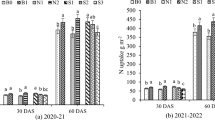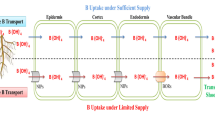Abstract
This paper summarizes recent achievements in exploiting new biological nitrogen fixation (BNF) systems in rice fields, improving their management, and integrating them into rice farming systems. The inoculation of cyanobacteria has been long recommended, but its effect is erratic and unpredictable. Azolla has a long history of use as a green manure, but a number of biological constraints limited its use in tropical Asia. To overcome these constraints, the Azolla-Anabaena system as well as the growing methods were improved. Hybrids between A. microphylla and A. filiculoides (male) produced higher annual biomass than either parent. When Anabaena from high temperature-tolerant A. microphylla was transferred to Anabaena-free A. filiculoides, A. filiculoides became tolerant of high temperature. Azolla can have multiple purposes in addition to being a N source. An integrated Azolla-fish-rice system developed in Fujian, China, could increase farmers' income, reduce expenses, and increase ecological stability. A study using Azolla labeled with 15N showed the reduction of N losses by fish uptake of N. The Azolla mat could also reduce losses of urea N by lowering floodwater-pH and storing a part of applied N in Azolla. Agronomically useful aquatic legumes have been explored within Sesbania and Aeschynomene. S. rostrata can accumulate more than 100kg N ha-1 in 45 d. Its N2 fixation by stem nodules is more tolerant of mineral N than that by root nodules, but the flowering of S. rostrata is sensitive to photoperiod. Aquatic legumes can be used in rainfed rice fields as N scavengers and N2 fixers. The general principle of integrated uses of BNF in rice-farming systems is shown.
Similar content being viewed by others
References
Alazard D and Becker M 1987 Aeschynomene as green manure for rice. Plant and Soil 101, 141–143.
Antonie T, Carro S, Mecha J C and VanHove C 1986 Comparative appetency for Azolla of Cichlasoma and Oreochromis tilapia. Aquaculture 53, 95–99.
Arunin S, Dissataporn C, Anuluxtipan Y and Nana D 1988 Potential of Sesbania as green manure in saline soils in Thailand. In Sustainable Agriculture. Green Manure in Rice Farming. pp 83–95. International Rice Research Institute. Los Baños, Philippines.
Becker M, Ladha J K and Ottow J C G 1988 Stem-nodulating legumes as green manure for lowland rice. Philip. J. Crop Sci. 13, 121–127.
Becker M, Ladha J K and Ottow J C G 1990 Growth and N2-fixation of two stem-nodulating legumes and their effect as green manure in lowland rice. Soil Biol. Biochem. 22, 1109–1119.
Desmadyl D, Godard P, Wauthelet M and Van Hove C 1988 Phosphorus needs and accumulation potential of various Azolla species and strains. Proc. 3rd Meeting of African Association for Biological Nitrogen Fixation 7–12 Nov. 1988, Dakar, Senegal.
Do V C, Watanabe I, Zimmerman W J, Lumpkin T A and DeWaha Baillonville T 1989 Sexual hybridization among Azolla species. Can. J. Bot. 67, 3482–3485.
Dreyfus B L and Dommergues Y R 1981 Nitrogen fixing nodules induced by Rhizobium on the stems of the tropical legumes Sesbania rostrata. FEMS Microbiol. Lett. 10, 313–317.
FAO 1988 The ‘Rice-Azolla-Fish’ System. RAPA Bulletin Vol. 4.
George T, Ladha J K, Buresh R J and Garrity D P 1992 Managing native and legume-fixed nitrogen in lowland rice-based cropping systems. Plant and Soil 141, 69–91.
Janiya J D and Moody K 1981 Weed suppression in transplanted rice with Azolla pinnata R. International Pest Control 5, 136–137.
Johnson A 1988 Azolla-the all-purpose crop. Asian Agribusiness 5, 14–15.
Kikuchi M, Watanabe I and Haws L D 1984 Economic evaluation of Azolla use in rice production. In Organic Matter and Rice. pp 569–592. The International Rice Research Institute. Los Baños, Philippines.
Kroeck T, Alkaemper J and Watanabe I 1988 Effect of an Azolla cover on the conditions in floodwater. J. Agron. Crop Sci. 161, 185–189.
Kushari D P and Watanabe I 1991 Differential responses of Azolla to phosphorus deficiency. Part I. Screening methods in quantity-controlled condition. Soil Sci. Plant Nutr. 37, 271–282.
Ladha J K, Pareek R P, So R and Becker M 1991 Stem nodule symbiosis and its unusual properties In Nitrogen Fixation: Achievements and Objectives. Eds. P M Gresshoff, L E Roth, G Stacey and W E Newton. pp 633–640. Chapman and Hall, New York; London.
Ladha J K, Watanabe I and Saono S 1988 Nitrogen fixation by leguminous green manure and practices for its enhancement in tropical lowland rice. In Sustainable Agriculture: Green Manure in Rice Farming. pp 165–183. International Rice Research Institute, Los Baños, Philippines.
Latorre C, Lee J H, Spiller H and Shanmugam K T 1986 Ammonium ion-excreting cyanobacterial mutants as a source of nitrogen for growth of rice: A feasibility study. Biotechnol. Letters 8, 507–512.
Li Z X, Zhu S X, Mao M F and Lumpkin T A 1982 Study on the utilization of 8 Azolla species in agriculture. Zhungguo Nongye Kexue 1, 19–27.
Lin C, Liu Z Z, Zheng D Y, Tang L F and Watanabe I 1989 Re-establishment of symbiosis to Anabaena-free Azolla. Science in China 32B, 551–559.
Liu C C 1987 Reevaluation of Azolla utilization in agricultural production. In Azolla Utilization. pp 67–76. International Rice Research Institute, Los Baños, Philippines.
Liu Z Z (Liu C C) and Zheng W W 1989 Azolla in China. Agric. Publishing House, Beijing. 427 p.
Lu S Y 1987 Methods for using Azolla filiculoides sporocarps to culture sporophytes in the field. In Azolla Utilization. pp 27–32. International Rice Research Institute, Los Baños, Philippines.
Meelu O and Morris R 1988 Green manure management in rice based cropping systems. In Sustainable Agriculture: Green Manure in Rice Farming. pp 209–222. International Rice Research Institute, Los Baños, Philippines.
Mochida O, Yoshiyasu Y and Dimaano D 1987 Insect pests of Azolla in the Philippines. In Azolla Utilization. pp 207–222. International Rice Research Institute, Los Baños, Philippines.
Nierzwicki-Bauer S A 1990 Azolla-Anabaena symbiosis: Use in agriculture. In Handbook of Symbiotic Cyanobacteria. Ed. RHaeselkorn. pp 119–136. CRC Press, Boca Raton, FL.
Okoronko N, VanHove C and Eskew D L 1989 Evaluation of nitrogen fixation by different strains of the Azolla-Anabaena symbiosis in the presence of a high level of ammonium. Biol. Fert. Soils 7, 275–278.
Payawal P C and Paderson E M 1987 Sporocarps formation and spore germination of Azolla strains in the Philippines. Phil. Agric. 69, 633–643.
Reddy P M and Roger P A 1988 Dynamics of algal populations and acetylene-reducing activity in five rice soils inoculated with blue-green algae. Biol. Fertil. Soils 6, 14–21.
Roger P A, Grant I F, Reddy P M and Watanabe I 1987 The photosynthetic aquatic biomass in wetland rice fields and its effect on nitrogen dynamics In Efficiency of Nitrogen Fertilizers for Rice. pp 46–68. International Rice Research Institute, Los Baños, Philippines.
Roger P A and Watanabe I 1986 Technologies for utilizing biological nitrogen fixation in wetland rice: Potentialities, current usage, and limiting factors. Fertil. Res. 9, 39–77.
Roger P A 1991 Reconsidering the utilization of blue-green algae in wetland rice cultivation. In Biological N2-Fixation Associated With Rice Production. pp 119–141. Oxford and IBH Publ., New Delhi, India.
Roger P A and Ladha J K 1992 Biological N2 fixation in wetland rice fields: Estimation and contribution to nitrogen balance. Plant and Soil 141, 41–55.
Shi D J and Hall D O 1988 The Azolla-Anabaena association: Historical perspective, symbiosis and energy metabolism Bot. Rev. 54, 353–386.
Shiomi N and Kitoh S 1987 Use of Azolla as a decontaminant in sewage treatment. In Azolla Utilization. pp 169–176. International Rice Research Institute, Los Baños, Philippines.
Vaishampayan A 1984 Biological effects of a herbicide on a nitrogen-fixing cyanobacteria (blue-green alga): An attempt for introducing herbicide-resistance. New Phytol. 96, 7–11.
Villegas G G and San Valentin G O 1989 Effect of Azolla cover on nitrogen and rice in flooded Mahaas clay. In Azolla: Its Culture, Management and Utilization in the Philippines. pp 65–90. National Azolla Action Program. The Univ. of the Philippines, Los Baños, Philippines.
Watanabe I 1986 Problems of using nitrogen fixation in the tropics. In Nitrogen Fixation with Non-Legumes. Eds. F A Skinner and PUomala. pp 343–357. Martinus Nijhoff Publishers, The Hague, The Netherlands.
Watanabe I and Cholitkul W 1990 Phosphorus as a factor limiting nitrogen fixation in flooded rice soils. In Phosphorus Requirement for Sustainable Agriculture in Asia and Oceania. pp 281–294. International Rice Research Institute, Los Baños, Philippines.
Watanabe I, Lapis T M, Oliveros R and Ventura W 1988 Improvement of phosphate fertilizer application to Azolla. Soil Sci. Plant Nutr. 34, 557–569.
Watanabe I, Lin C and Ventura T 1989 Responses to high temperature of the Azolla-Anabaena association, determined in both the fern and in the cyanobacterium. New Phytol. 111, 625–630.
Watanabe I and Ramirez C 1990 Phosphorus and nitrogen contents of Azolla grown in the Philippines. Soil Sci. Plant Nutr. 36, 319–331.
Watanabe I and Roger P A 1984 Nitrogen fixation in wetland rice field. In Current Developments in Biological Nitrogen Fixation. Ed. N S SubbaRao. pp 237–276. Oxford & IBH, New Delhi.
Wauthelet M, Desmadyl D, Godard P and Van Hove C 1988 Sensitivity to aluminum of various Azolla species and strains. Proc. 3rd Meeting of African Association for Biological Nitrogen Fixation 7–12 Nov. 1988, Dakar, Senegal.
Wei W X, Jin G Y and Zhang N 1986 Preliminary report on Azolla hybridization studies. Bull. Fujian Acad. Agric. Sci. 1, 73–79. (In Chinese).
Zimmerman W J, Rosen B H and Lumpkin T A 1989 Enzymatic, lectin, and morphological characterization and classification of presumptive cyanobionts from Azolla Lam. New Phytol. 113, 497–503.
Author information
Authors and Affiliations
Rights and permissions
About this article
Cite this article
Watanabe, I., Liu, C.C. Improving nitrogen-fixing systems and integrating them into sustainable rice farming. Plant Soil 141, 57–67 (1992). https://doi.org/10.1007/BF00011310
Issue Date:
DOI: https://doi.org/10.1007/BF00011310




